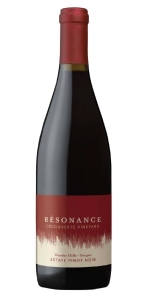Wine from Resonance

It was a crisp spring day in April 2013 when Thibault Gagey and Jacques Lardière set out to survey a well-established vineyard named Résonance. Jacques had just retired after leading winemaking at Maison Louis Jadot for 42 years, and Thibault, whose family has operated Maison Louis Jadot since 1962, was ready to enter the business with a bold new project. They immediately felt a deep connection with the place, and after tasting through dozens of wines made with the vineyard’s fruit, Jacques sat back and said, “Perfect.”
Pierre-Henry Gagey, the President of Maison Louis Jadot and Thibault’s father, agreed. They decided to keep the vineyard’s title, and they also named their new winery—Maison Louis Jadot’s first outside of Burgundy—in its honor. With the same meaning in English and French, Résonance evokes many great things to come. They added the tiny but all-important accent mark to represent this small but special connection between Oregon and France.
Maison Louis Jadot was founded by the Jadot Family in 1859—the same year as the State of Oregon. Nurturing premier and grand cru vineyards in Burgundy, Maison Louis Jadot earned a reputation for world-class wines made in small lots, capturing the attention of Rudy Kopf, an importer for Kobrand Wine & Spirits and the founder of the wine and spirits division of Macy’s department store in New York. In 1945, Rudy made a pilgrimage to visit Maison Louis Jadot, and the long-standing relationship between the Kopf and Jadot Families commenced.
Rudy soon began importing Maison Louis Jadot wines to the U.S., and the partnership continued to blossom through shared investments and appreciation for the next four decades. In 1984, Madam Jadot transferred ownership of the historic wine estate to the Kopf Family.
The relationship between the Gagey Family and Maison Louis Jadot also goes back to the mid-20th Century, when Louis Auguste Jadot invited a young winemaker named André Gagey to join his team of vintners in 1954. André was bestowed the title of President of Maison Louis Jadot when Louis Auguste Jadot passed away in 1962.
With winemaking traditions going back generations on both sides of his family, he worked closely with the Jadot and Kopf Families to build Maison Louis Jadot into the world-class global wine brand it is today. In 1992, Pierre-Henry, André’s son, took over the role of President, and he launched the search for Maison Louis Jadot’s first winery in the New World in the early 2000s. As fortune would have it, Pierre-Henry discovered Résonance Vineyard at the exact moment when the next generation of the Gagey Family, Thibault Gagey, was ready to enter the business. Thibault became the Director of Operations of Résonance in 2013.
Resonance Decouverte Vineyard Pinot Noir is made from 100 percent Pinot Noir.
The wine reflects a beautiful and brilliant garnet color, with an expressive and complex nose of strawberry, plum, wild cherry, almond and licorice. The wine reveals an elegant palate, vibrant and complex, with delicate notes of noble wood, and very long and mineral finale.
Review:
James Suckling 93 Points
- back
Selected Options
Wineries
Categories
Pricing
Countries
Regions
Grape Types
Wineries
Organic/Free Shipping
Hall Wines The Kathryn Hall Cabernet Sauvignon is made from 96% Cabernet, 4% Merlot.
The 2017 Kathryn Hall is deep, dark ruby in color and elegantly balanced with layered aromas of concentrated blackberry, freshly turned earth, and a hint of warm, spicy oak. The palate is fruit-forward with underlying notes of rich cocoa and leather. Layers of black fruit, nutmeg, cassis and brooding earthy notes are abundant. Supple, seamless tannin abounds, and the wine finishes with an incredible dark fruit feed-back that lasts several minutes.
Review:
The 2019 Cabernet Sauvignon Kathryn Hall is a blend of 95% Cabernet Sauvignon and 5% Merlot, brought up mostly in new barrels. It’s a killer bottle of wine offering lots of ripe black fruits intermixed with savory herbs, melted chocolate, and tobacco. Medium to full-bodied on the palate, it shows the lush, round, velvety style of the 2019 vintage and is already impossible to resist. It’s going to evolve for 15+ years if well stored.
-Jeb Dunnuck 95 Points
Thierry Mortet Gevrey Chambertin Vigne Belle is made from 100 percent Pinot Noir.
The wine is produced from 20 different parcels (3 hectares total). The soils are a mix of clay and silt.
The age of wines varies between 15 to 60 years.
Yield: 45 hl/ha
Production: 15,000 bottles on average.
Manual harvest with a selection of the grapes; sorting table; 100% destemming; maceration for 15 days, cold stabilization for 4-5 days; M-L.; racking twice a day. Fermentation in stainless steel tanks for 4 months. Aging in oak barrels for 12 months (new and 1 or 2 year old barrels). Kieselguhr filtration before bottling.
The wine offers a subtle and complex nose. It displays a sweet and delicate mouthfeel. Very nice wine with black fruit aromas. Dense, good concentration. Good length and well integrated oak.





